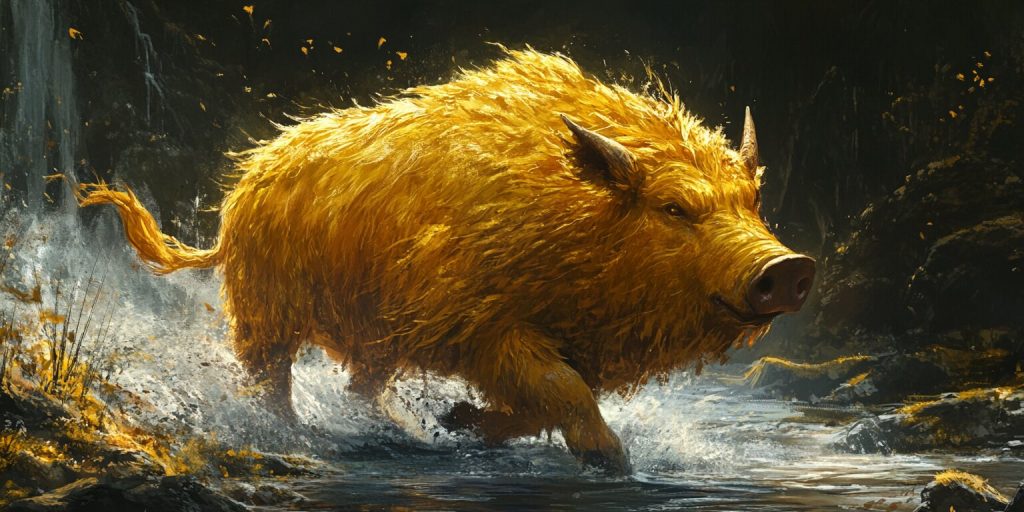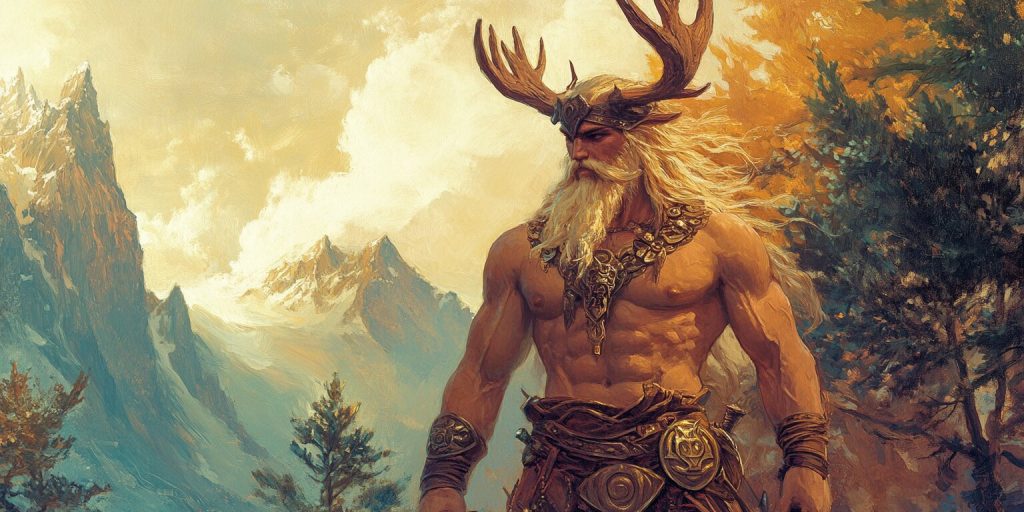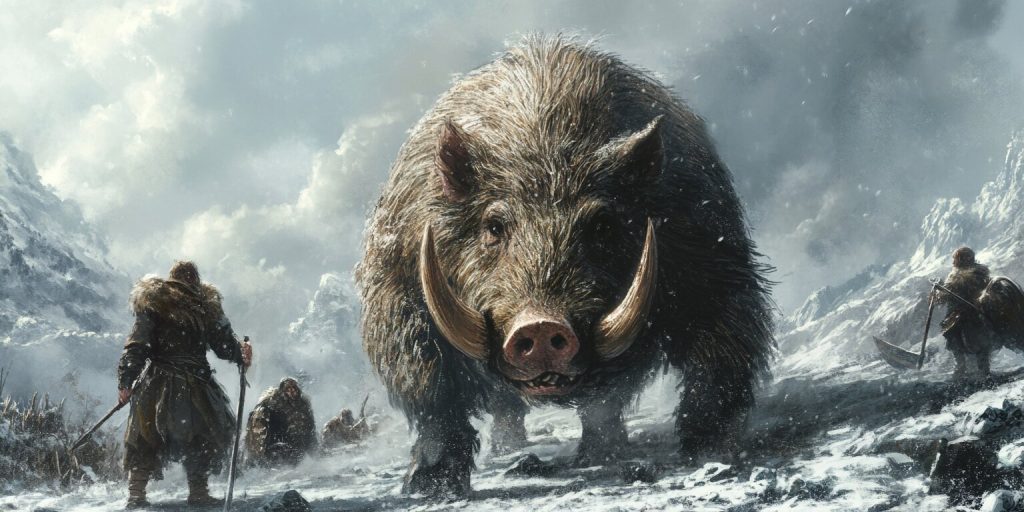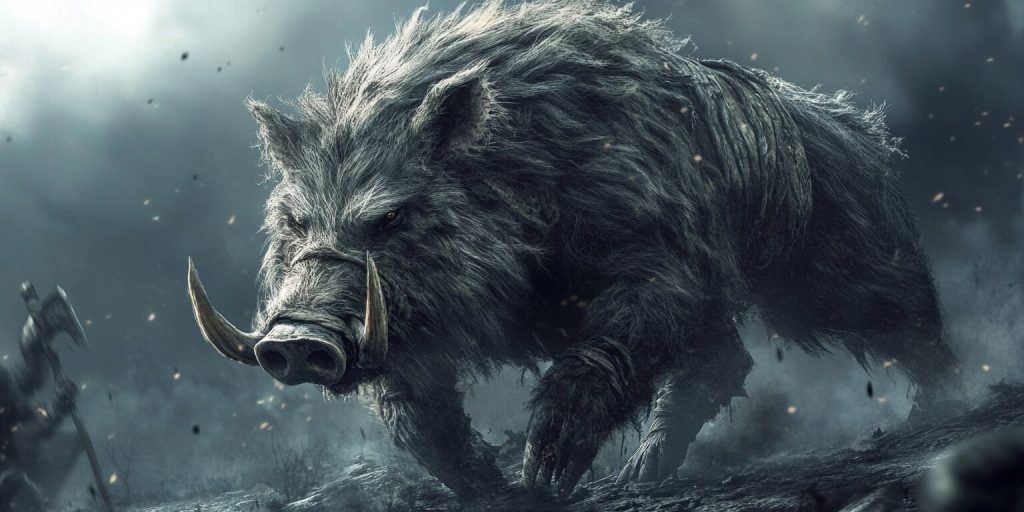Creatures in Norse mythology, Dwarves, Freyr, Gullinbursti, Norse Gods, Norse Mythology, Vanir Gods
Boar Norse Mythology: The Powerful Beast in Viking Legends
The boar is a key figure in Norse mythology, often linked to the divine feasts in Valhalla. In Viking culture, it stands for strength, bravery, and fertility. It’s not just a food source but also a symbol of wealth and the warrior’s code.
The boar links to gods like Freyr and is a big part of folklore. This piece examines how the boar shaped Viking stories and its deep meaning in Norse beliefs.
The Symbolism of the Boar in Norse Culture
The boar is very important in Norse culture. It stands for power, courage, and fertility. In Viking society, this animal was more than just a wild creature. It symbolized the warrior spirit and the Norse way of life.
Warriors looked up to the boar for its strength and bravery, symbolizing courage and toughness.
Many gods were linked to the boar, making it even more special. Freyr, the god of fertility and wealth, was often connected with it. The boar showed strength and was key in rituals and ceremonies.
Its presence helped link the world of the living with the spiritual world. This shows how important the boar was in Norse culture.
- The boar symbolizes military strength, as seen on shields and banners.
- Art and crafts show the boar, highlighting its high status.
- Ceremonies like sacrifices and offerings to honor boar-linked gods.
The boar linked people with their beliefs, showing its key role in life and spiritual practices. Its deep bond with humans proves its significant impact on Norse culture.
Boar Norse Mythology: Significance in Viking Legends
The boar is a key figure in Norse mythology. It’s linked to Viking legends and seen as a symbol of strength and victory. These creatures are often seen with the gods, showing their power and protection.
Boars are closely tied to gods like Freyr, the god of fertility. Freyr’s boar, Hildisvíni, stands for abundance. Seeing a boar in battle meant victory was likely, boosting the warriors’ confidence.
Boars also show the Viking spirit of bravery and honor. They were part of Viking culture and showed their values in stories. These tales highlight the boar’s role in Norse mythology, adding depth to Viking legends.
The Golden Boar: Gullinbursti

In Norse mythology, the golden boar Gullinbursti stands out, often associated with the goddess Freyja. It shows the amazing skills of the dwarves, particularly Eitri, in crafting such legendary creatures. Made by Brokkr and Sindri, Gullinbursti is more than a creature. It’s a symbol of wealth, abundance, and success.
The story of its creation is full of tales of northern craftsmanship. It shows how important art was in ancient times.
Creation by the Dwarves
The dwarven brothers Brokkr and Sindri made Gullinbursti. They used magical pigskin to make this golden boar Norse. It has magical powers.
This shows the dwarves’ skill in Norse mythology. They also made Thor’s hammer and Odin’s ring.
Gullinbursti’s Role in the Myths
Gullinbursti is important in many myths. It’s often linked with gods, especially Freyr. As a mount, it means abundance and fertility.
It’s seen as a sign of prosperity, much like Freyja’s blessings. This makes Gullinbursti a sacred creature, and it shows how creatures in Norse myths have deep meanings.
The Wild Boar in Norse Folklore
The wild boar is a big part of Norse folklore, seen as a vital Norse boar symbol. It shows power and mystery. Stories about these animals tell us about humans and nature. They show how much the Vikings respected wildlife.
Wild boars are in many legends. They are seen as:
- Protectors of the forest, keeping safe the lands of humans and gods.
- Signs of change or omens, warning of big events in the community.
- Symbols of strength and toughness, showing traits Vikings admired in warriors.
Wild boars in stories remind Vikings of the wild forces they both feared and respected. These animals lived in the old woods. They showed the tough challenges and spiritual parts of the Viking life.
As powerful figures in Norse stories, wild boars symbolize the deep bond between humans and nature. They contribute to the rich stories from Old Norse that still touch our hearts today.
Freyr and His Connection to Boars
Freyr is the Norse god of fertility and prosperity. He is deeply linked to boars, symbolizing growth, abundance, and farming success. This bond shows how important boars are in Norse culture, especially for wealth and health.
Fertility and Prosperity Symbols
Freyr is known for bringing fertility and good weather, which are key for farming and harvesting. His link to boars makes them symbols of farming success. Boars were seen as strong and full of life, like Freyr himself.

Having boars in rituals and celebrations showed their key role. They helped ensure good harvests and a good life.
Freyr’s Boar Hildisvíni
Hildisvíni, Freyr’s boar, is a key part of the story. It stands for food and plenty and also protects in battles. The boar shows Freyr’s role as a giver and a protector.
This shows how nature and gods are connected in Norse stories.
Viking Ceremonies and the Boar
In Viking ceremonies, the boar was more than just a symbol. It was a powerful gift to the gods during feasts and rituals, which aimed to bring fertility and prosperity. In Norse mythology, the boar was seen as a symbol of strength and plenty, often represented in warriors’ helmets.
Boars were often sacrificed to deities in Viking ceremonies. This act showed a deep bond with nature and the gods. The boar was seen as a link between humans and the divine.
Viking boars were also present in commemorative rituals. These events helped communities remember their heritage and celebrated the boar as a symbol of unity and strength.
Viking ceremonies honored their traditions and connection to their deities, including the worship of Freyja. The boar played a big part in their cultural identity.
The boar’s role in viking life showed its deep spiritual and communal importance. It was not just an animal but a key figure in their spiritual and social life.
The Magical Bristles of the Norse Mythology Boar
The Norse boar is a mythical figure known for its magical bristles. These bristles are more than just hair; they are symbols of deep magic. Legends say these bristles glow in the dark, lighting the way in battles.
This light shows the boar’s mystical powers. In Norse stories, the boar is seen as a protector and guide. The magical boar plays a big role in culture.
Properties of the Bristles
The bristles of the Norse boar have amazing qualities that make them legendary:
- They can light up the dark, helping people find their way.
- They are linked to fertility and protection, showing their deep meaning.
- They help warriors feel brave and strong in fights.
The magical boar is deeply rooted in Norse myths. Its bristles are key to its magic. They connect to powerful energies needed for Viking survival and success.
Boar Hunting in Viking Life
Boar hunting was a big deal for the Vikings. It was a mix of getting food and showing off their Norse culture. It was a way for young warriors to prove themselves.

They used different methods and tools for hunting boars. Hunters used:
- Sharp spears for striking from a distance.
- Traps to catch the boars.
- Dogs trained to track and corner the beasts.
This wasn’t just about hunting. It helped warriors prepare for battle and taught them important skills like strategy and teamwork.
In Norse culture, the boar was seen as a symbol of strength. Hunting together brought people closer. They shared stories and celebrated their victories with feasts.
Mythical Creatures: The Role of the Boar
The mythical boar is important in Norse mythology, especially in stories like Beowulf. It is known for its great strength and link to battle. The boar stands for courage and the warrior spirit. It is a key symbol in the old culture of Scandinavian people.
Beowulf and the Boar’s Significance
In Beowulf, the boar is a strong symbol of bravery and toughness. This epic poem shows the boar as a symbol that gives warriors strength and protection in fights. The boar’s image shows how it makes heroes fearless.
Cultural Representations of the Boar
The boar’s importance goes beyond stories, showing up in art, artifacts, and folklore. In different forms, the boar stands for fertility, plenty, and being part of nature. Art shows its role in rituals and ceremonies. This shows how the boar still affects our view of Norse heritage today, echoing tales of Valhalla.
The Prose Edda and Boar Tales
The Prose Edda is key to understanding Norse mythology. It tells us about myths and legends, including boar stories that Snorri documented. These stories show how important boars were in the culture.
A famous story is about the boar Gullinbursti. Dwarves made it for the god Freyr. This tale shows the dwarves’ skill and how boars are linked to fertility and plenty in Norse myths. Freyr’s link to the boar shows its role in farming and wealth, showing Viking values.
Another part of the Prose Edda talks about boar bristles. These bristles were magical, helping warriors win battles and protecting them. This shows how much Vikings respected boars and their impact on life and beliefs.
The Prose Edda keeps these stories alive. It lets us see into the spiritual life of the Norse. It shows how boars were part of their myths and rituals. Knowing these stories helps us understand the boar’s importance in Viking culture.
Boar Representations in Art and Literature
The boar is a key figure in Norse culture. It has appeared in art and literature throughout history, and its depictions show its strength and deep meaning in Viking society.
Norse art often features the boar in many ways. You can see it in detailed carvings and beautiful tapestries. Each piece shows the boar’s bravery and role in the lives of warriors and hunters.
In stories, the boar stands for strength and safety. Epic tales describe boars as protectors, akin to the legendary mane of the great beasts. They show courage and toughness against hard times. These stories add to the boar’s legend, showing its value in Norse culture.
- Symbolic meanings associated with boars in Norse culture
- Artistic styles and methods used in boar representations
- Literary discussions featuring boars as central motifs
Over time, boar representations have changed but kept their core values. This shows how art and literature keep the boar’s important place in Norse culture. The boar’s lasting impact in art and stories shows its deep meaning to Norse people, inspiring many with its symbolism.
Conclusion
The boar is a key figure in Norse mythology. It stands for strength, power, and the bond between humans and nature. Through myths and stories, we see the boar’s role goes beyond just being a symbol. It connects us to fertility, protection, and life cycles, vital to the Vikings.
Looking into the boar’s cultural importance shows its big role in Norse stories, old and new. Stories of creatures like Gullinbursti and links to gods like Freyr show the boar’s key values in Viking life, deepening our understanding of their culture and beliefs.
The boar’s lasting impact in Norse mythology shows its complex nature. It reminds us of the old stories that still touch our lives today. By exploring the boar’s layers, we learn more about Viking culture and its effect on our stories.

